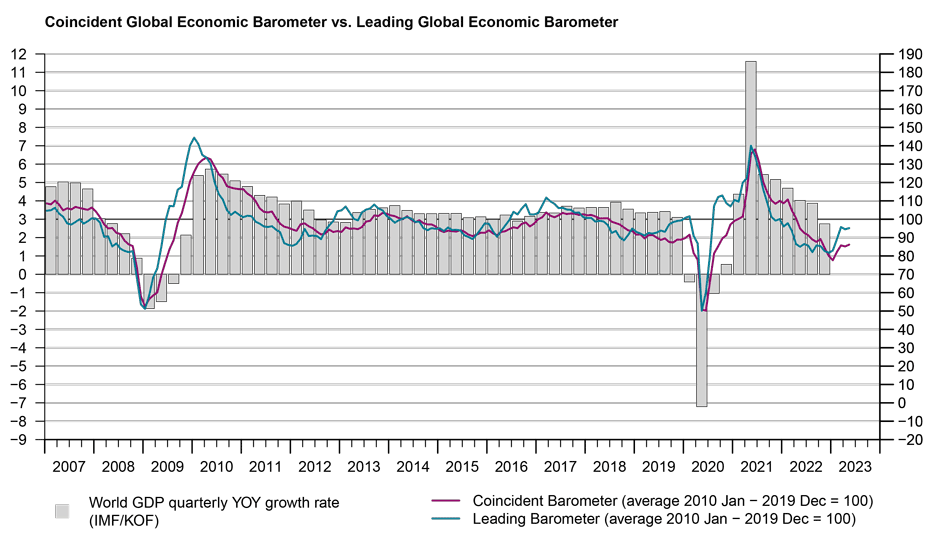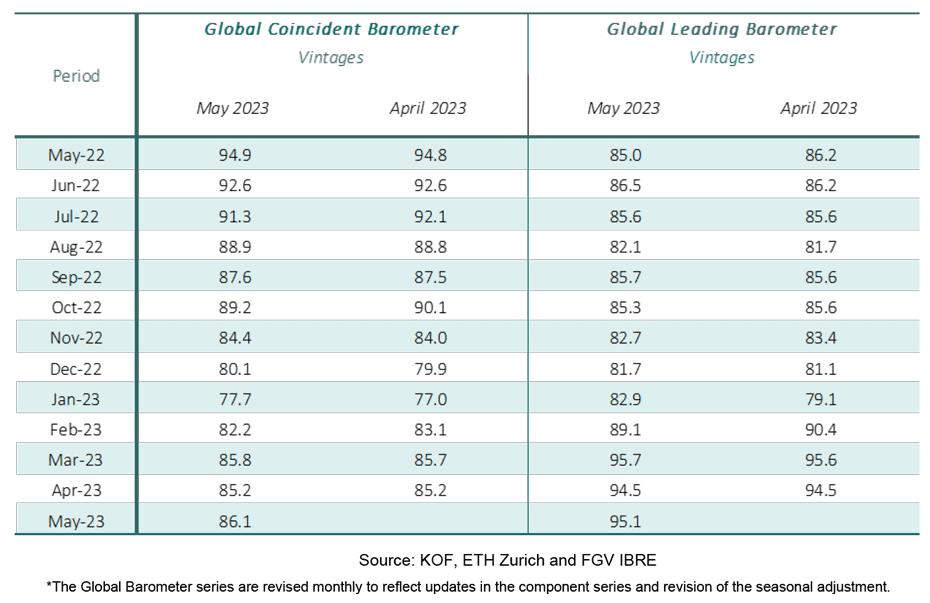Global Barometers improve slightly but remain at subdued levels
The Global Barometers rise only slightly in May, reflecting continued weakness in global economic activity in most countries and moderate optimism, partly related to the gradual recovery of the Chinese economy.
The Coincident and Leading Global Economic Barometers increase by 0.9 and 0.6 points, respectively, in May 2023. The slight increase is mainly due to the performance of the Asia, Pacific & Africa and Western Hemisphere regional indicators in the case of the Coincident Barometer, and the Asia, Pacific & Africa region in the case of the Leading indicator. With these results, both indicators continue to fluctuate below their historical average of 100 points, with the Coincident Barometer closing the month at 86.1 points and the Leading Barometer at 95.1 points.
“Although both the outlook and the current assessment of the global economy have improved, the global economy remains subdued and there are few signs that this will change in the near future. Much of the current hope is pinned on Asia, and China in particular. In the western world, stubbornly persistent inflation rates and the associated rise in interest rates do not support a rapid recovery. At the same time, labour market conditions remain tight in many countries, suggesting that the current subdued situation is also supply-side driven”, evaluates Jan-Egbert Sturm, Director at KOF Swiss Economic Institute.

“Although both the outlook and the current assessment of the global economy have improved, the global economy remains subdued and there are few signs that this will change in the near future.”Jan-Egbert Sturm, Director at KOF Swiss Economic Institute
Coincident Barometer – regions and sectors
In May, the Asia, Pacific & Africa region and the Western Hemisphere contribute 0.6 and 0.4 points, respectively, to the increase in the Coincident indicator, while Europe contributes negatively with -0.1 point. The three regional indicators are in the 80-90 point range, reflecting the impact of monetary tightening in most countries, in parallel with the gradual recovery of the Chinese economy. The graph below shows the contribution of each region to the deviation of the Coincident Barometer from its historical average of 100 points.
With the exception of Services, all the Coincident sector indicators increase this month. With this result, Trade records the highest level among the sectors, followed by the general state of the Economy (aggregated business and consumer evaluations). The Construction indicator records a second consecutive increase, accumulating more than 17 points in the April-May period, further reducing the gap to the other sectors.
Leading Barometer – regions and sectors
The Leading Global Barometer leads the world economic growth rate cycle by three to six months on average. In May 2023, only the Asia, Pacific & Africa region contributes positively to the result, with 2.3 points, while Europe and the Western Hemisphere contribute negatively, with -1.0 and -0.6 points, respectively. The gap between the indicators for the Asia, Pacific & Africa region and the Western Hemisphere is more than 16 points, suggesting improved economic growth expectations in the former, while the inflationary environment and high interest rates suggest a more pessimistic outlook for the Western Hemisphere countries.
The sectoral leading sector indicators show contrasting results in May, with the Economy and Services rising and Construction, Industry and Trade falling. The Economy indicator, which reflects aggregated business and consumer assessments, reaches a level above 100 points, its highest level since August 2021 (112.9 points), while Construction, which had accumulated an increase of over 10 points over the previous three-months, fell sharply in May, moving away from the levels of the other sectors.
The Global Economic Barometers
The Global Economic Barometers are a system of indicators enabling timely analysis of global economic development. They represent a collaboration between the KOF Swiss Economic Institute of the ETH Zurich in Switzerland and Fundação Getulio Vargas (FGV), based in Rio de Janeiro, Brazil. The system consists of two composite indicators, the Coincident Barometer and the Leading Barometer. The Coincident Barometer reflects the current state of economic activity, while the Leading Barometer provides a cyclical signal roughly six months ahead of current economic developments.
The two Barometers comprise the results of economic tendency surveys conducted in more than 50 countries with the aim of achieving the broadest possible global coverage. The advantages of economic tendency surveys are that their results are usually readily available and are not substantially revised after first publication.
The Coincident Barometer includes more than 1,000 different time series, while the Leading Barometer consists of over 600 time series. Cross-correlation analysis is used to decide which individual time series are included in the barometers. This involves correlating the individual time series with a reference series. The reference series used is the year-on-year growth rate of global gross domestic product (GDP), where the individual national GDPs are aggregated at purchasing power parity to form global GDP. A time series is only included in a Barometer if it shows a sufficiently high correlation and a suitable synchronization or lead with the reference series. The time period used for this correlation analysis currently runs from January 2010 to December 2019.
The series of the two Barometers are revised each month at publication and are standardized to have a mean of 100 and a standard deviation of 10 for the 10-year period previous to the most recent observations.
The methodology is described in:
Klaus Abberger, Michael Graff, Aloisio Jr. Campelo, Anna Carolina Lemos Gouveia, Oliver Müller and Jan-Egbert Sturm (2020), The Global Economic Barometers: Composite indicators for the world economy. KOF Working Papers, vol. 471, Zurich: KOF Swiss Economic Institute, ETH Zurich, 2020.
Contact
KOF Konjunkturforschungsstelle
Leonhardstrasse 21
8092
Zürich
Switzerland



